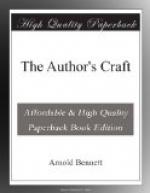II
In considering the equipment of the novelist there are two attributes which may always be taken for granted. The first is the sense of beauty—indispensable to the creative artist. Every creative artist has it, in his degree. He is an artist because he has it. An artist works under the stress of instinct. No man’s instinct can draw him towards material which repels him—the fact is obvious. Obviously, whatever kind of life the novelist writes about, he has been charmed and seduced by it, he is under its spell—that is, he has seen beauty in it. He could have no other reason for writing about it. He may see a strange sort of beauty; he may—indeed he does—see a sort of beauty that nobody has quite seen before; he may see a sort of beauty that none save a few odd spirits ever will or can be made to see. But he does see beauty. To say, after reading a novel which has held you, that the author has no sense of beauty, is inept. (The mere fact that you turned over his pages with interest is an answer to the criticism—a criticism, indeed, which is not more sagacious than that of the reviewer who remarks: “Mr Blank has produced a thrilling novel, but unfortunately he cannot write.” Mr Blank has written; and he could, anyhow, write enough to thrill the reviewer.) All that a wise person will assert is that an artist’s sense of beauty is different for the time being from his own.
The reproach of the lack of a sense of beauty has been brought against nearly all original novelists; it is seldom brought against a mediocre novelist. Even in the extreme cases it is untrue; perhaps it is most untrue in the extreme cases. I do not mean such a case as that of Zola, who never went to extremes. I mean, for example, Gissing, a real extremist, who, it is now admitted, saw a clear and undiscovered beauty in forms of existence which hitherto no artist had deigned seriously to examine. And I mean Huysmans, a case even more extreme. Possibly no works have been more abused for ugliness than Huysman’s novel En Menage and his book of descriptive essays De Tout. Both reproduce with exasperation what is generally regarded as the sordid ugliness of commonplace daily life. Yet both exercise a unique charm (and will surely be read when La Cathedrale is forgotten). And it is inconceivable that Huysmans—whatever he may have said—was not ravished by the secret beauty of his subjects and did not exult in it.




